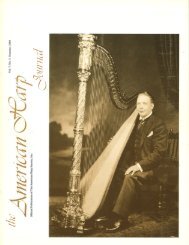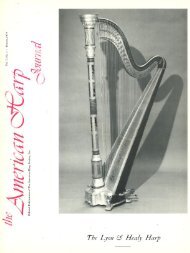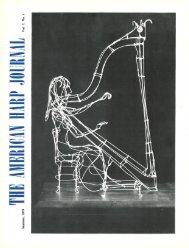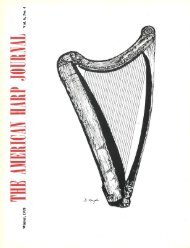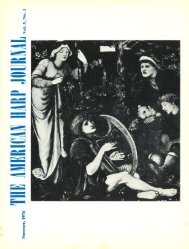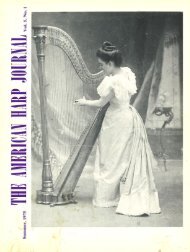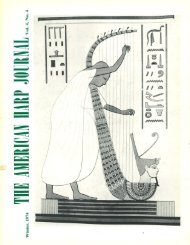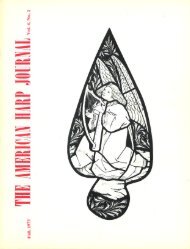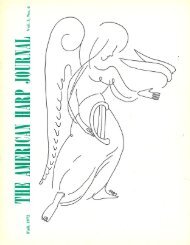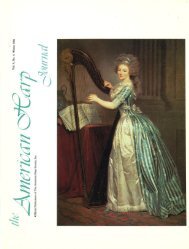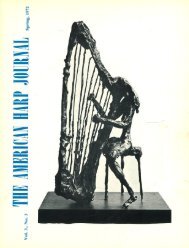You also want an ePaper? Increase the reach of your titles
YUMPU automatically turns print PDFs into web optimized ePapers that Google loves.
and a long and lucrative Brazilian tour about the time<br />
of the marriage enabled Zabaleta to think of attempting<br />
to establish himself at last in Europe.<br />
Doors did not open easily or quickly and<br />
everywhere it seemed that his Latin American success<br />
was not good enough. In England he was told<br />
that Latin Americans had an affinity for the harp (the<br />
street harp), but that he could expect nothing similar<br />
there. In Germany the struggle started the same way<br />
but finally ended in success. "It was the same fight,<br />
but it went fantastically." Zabaleta feels that there is<br />
a meeting of the minds between Basque and German<br />
people. "We are more reserved, more introverted, not<br />
so given to emotional expression, we talk less."<br />
(Zabaleta, by the way, speaks four languages fluently:<br />
his native Basque and Castillian in addition to<br />
French and English.) His most successful recordings<br />
have been produced by the German firm DGG<br />
(Deutsche Grammophon Gesellschaft). These albums,<br />
the sales of which are rapidly climbing toward<br />
one and one-half million copies, have won a number<br />
of international prizes for artistic and recording excellence,<br />
and are heard on radio stations around the<br />
world. (A complete discography of Zabaleta recordings<br />
is appended at the end of this article.)<br />
Zabaleta has exerted perhaps a greater influence on<br />
current harp repertory than any other single artist: he<br />
was the first major recitalist to program primarily<br />
works composed originally for the instrument rather<br />
than the standard transcriptions and music by<br />
harpist-composers so favored in earlier times. He has<br />
conducted endless research to discover and recover<br />
valid works of the past, including especially the<br />
music of the masters of the Spanish Renaissance, and<br />
he has been honored with dedications by a number of<br />
contemporary composers. This latter category includes<br />
sonatas by Glanville-Hicks, Tailleferre, Hovhaness,<br />
and Krenek, and concertos by Milhaud, Rodrigo,<br />
Villa-Lobos, Piston, and Tal, to name just a few<br />
of the best known. In addition to the works written<br />
expressly for him, Zabaleta has introduced works of<br />
Virgil Thomson, Alberto Ginastera, and Carlos<br />
Surinach, among many others. Schott has issued his<br />
editions of works by Beethoven, Dussek, and Spanish<br />
masters of the 16th and 17th centuries, and more<br />
recently sonatas by M. Albeniz and J. Galles have<br />
been edited by Zabaleta for Lyra Music.<br />
More than three hundred of the world's largest<br />
orchestras have engaged him as soloist: the list includes<br />
the Israel Philharmonic, the Berlin Philharmonic,<br />
the Vienna Philharmonic, the Warsaw<br />
Philharmonic, the Royal Philharmonic of London,<br />
the Orchestre de Paris, the New York Philharmonic,<br />
and the Philadelphia Orchestra with which he gave<br />
the first performance of the Ginastera Concerto in-<br />
1965. Since his debut in New York in 1934, Zabaleta<br />
has given more than 2,500 recitals in the United<br />
States, Europe, Latin America, the Middle East and<br />
Japan, and has appeared at festivals at Berlin,<br />
Bucharest, Dubrovnik, Edinburgh, Lucerne, Osaka,<br />
<strong>Winter</strong>/<strong>1980</strong><br />
Original drawing of Nicanor Zabaleta by Linda Shennan.<br />
Rehearsing with Onnandy and the Philadelphia Orchestra for the<br />
first perfonnance of the Ginastera Concerto.<br />
5




